Is your dog left-handed or right-handed – or rather, is the left or right-pawed? You’ve probably never thought to ask the question, or even consider which paw your dog favors.
But, surprisingly, your dog likely uses one paw more dominantly over the other. And, which paw he chooses can actually affect how he chews his bones to the characteristics of his personality and behavior.
What dog breeds use their paws a lot? Dog breeds that use their paws more specifically and with intended purpose are generally those that are more muscular in nature, such as the boxer, as well as those who are more commonly trained to do so, such as hunting dogs and service dogs. Additionally, depending on the breed of your dog, his feet will vary in size and shape and may be more useful for swimming, rough terrain, or bearing weight.
Your dog’s paw preference and the degree to which he is able to use his paws are each linked to his temperament, and to some degree, his breed. His paws are not simply made for walking – they’re actually capable of quite a bit more.
Dogs Who Use Their Paws for Purpose
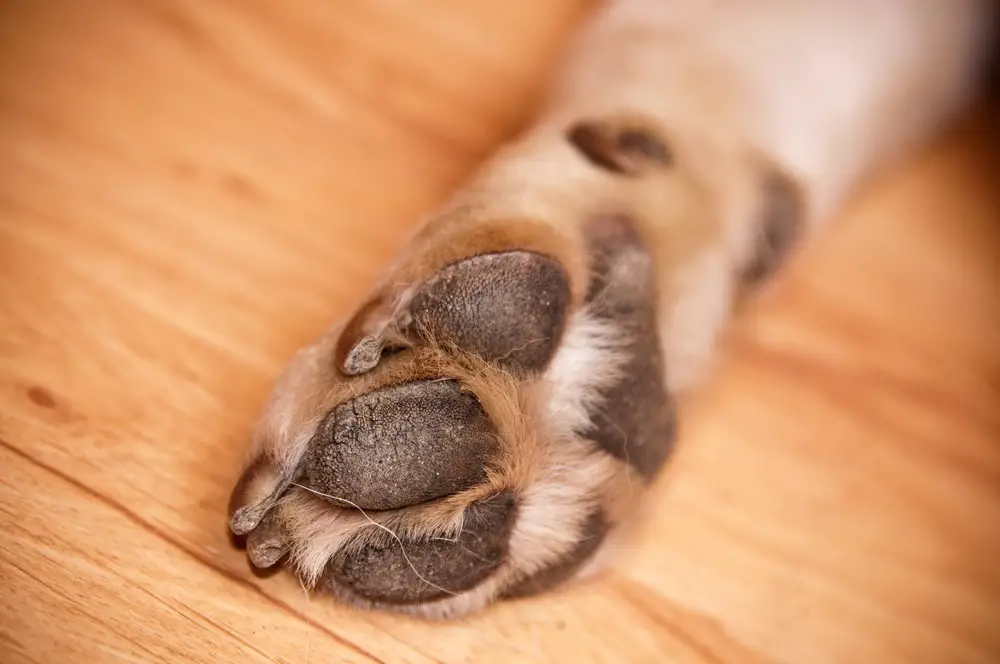
While paw use can vary from one dog to the next, all dogs use their paws with purpose. Of course, dogs use all four feet to walk, run, and play.
But what most of us never thought to consider is that dogs also use their paws to communicate in the same way that they use body language or barking to express a want or need (source).
Before we get into the specifics of how certain breeds may uniquely use their paws, we’ll first talk about the differences in paw shape and size across breeds, how to care for your dog’s feet, and how your dog may use his paws to communicate with you.
And, perhaps most fascinatingly, we’ll find out whether your dog is right or left “pawed,” or if he’s ambilateral (meaning he uses both front paws equally).
Characteristics and Classifications of Dog Paws
You’ve probably not spent much time analyzing your dog’s feet. But, if you stop and consider that your dog’s paws are akin to your own hands and feet, you’ll realize that they are a lot more important than they might seem.
And, there are differences in size, shape, and use. No human hand is exactly the same, and for dogs, paw shapes and sizes differ depending on evolutionary needs.
Paw parts
All paws share certain characteristics, including four pads that your dog uses to help him walk – on his toes, not on the sole of his foot like a human.
Also, each of those four pads gives your dog traction and shock absorption, protecting his bones and joints when running, jumping, and playing (source).
The pads of your dog’s paw also become rougher and more course over time, adding to his ability to run and turn quickly, while protecting him from cold temperatures since they are made up of fatty tissue that does not freeze as quickly as normal skin would.
There is also a smaller pad on your dog’s foot called a carpal pad. This smaller pad provides even more traction and helps your dog to slow down and stop abruptly and easily when sprinting across your yard to catch a ball – or a squirrel! It also helps your dog to stay balanced on all fours.
Similar to a human foot, your dog also has five toes, one of which is the dewclaw – though the dewclaw is most often found only on the front paws, not the hind paws.
The dewclaw is often compared to our thumb but does not have the same level of functionality and use.
Paw shapes and sizes
There are three general shapes to the dog’s feet, including cat feet, hare feet, and webbed feet (source).
If you thought these names odd, you aren’t alone – but, the similarity in feet between dogs, cats, and rabbits are not all that far off.
The shape of your dog’s paw is correlated with his breed, size, and how he uses his paws. Because many dogs are mixed breeds, they also often share characteristics of multiple paw shapes and/or sizes.
Below are the characteristics of different paw shapes and sizes.
Caring for Your Dog’s Feet
Even though your dog’s paws may be designed to withstand rough terrain, it is important that you pay particular attention to your dog’s feet and care for them well – they don’t have the protection of shoes as we do.
Wound care
Minor wounds are bound to occur and those that are small (less than ½ inch) can simply be cleaned with antibacterial soap and wrapped in a light bandage or gauze if necessary (source).
It is also a good idea to inspect your dog’s feet if you notice extensive licking, biting, or chewing, which could indicate an allergy or irritant (source).
You’ll want to check with your veterinarian if you notice any of these issues since it could be indicative of a bigger problem, but otherwise, if your dog’s paws are simply dry or cracked, look for a good moisturizer specifically made for dogs – human moisturizers can actually soften the pads too much and lead to further injury, so avoid those altogether.
Protection from hot and cold weather
Depending on the breed of your dog, your dog’s feet may be more durable in water for swimming, such as a Labrador, or in cold weather, such as a Newfoundland.
For cold weather care, a coat of Vaseline can protect your dog’s feet from ice melts and salts which can also be irritants.
And, in warm weather, be careful of extreme heat on hot pavement. Terrain that is too hot can lead to blisters and red patches on sensitive feet.
Here’s a short video about how to trim hair on your dog’s paw:
Is your Dog Using His Paws to Communicate with You?
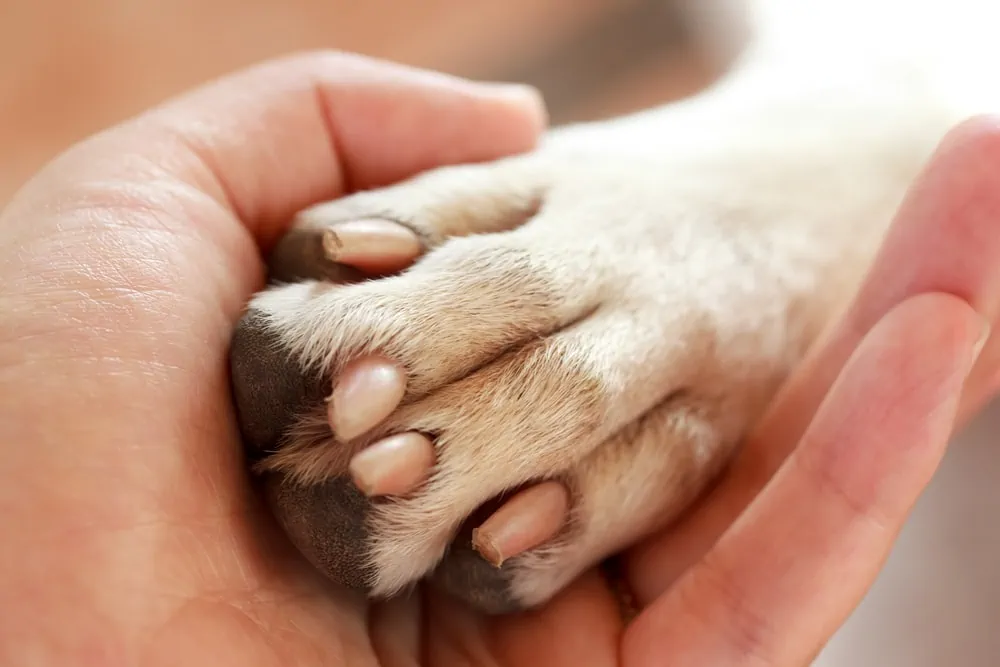
While certain dogs may be trained to use their paws more specifically for particular purposes, all dogs use their paws to communicate, whether that be to entice you to play or to show submission or dominance.
We often overlook a dog’s attempts to communicate with his paws, focusing on more common communication such as tail wagging or barking.
But, the ways in which your dog moves his legs and feet can reveal quite a bit about what he wants to tell you, or what he is trying to accomplish.
Playing, Claiming Ownership, or Asking for Attention
If your dog is seeking attention from you or wanting something you have in your hand, he may paw at you with his front legs, or bow down with his front feet in an open posture.
Pawing at an object (or your legs or hands) is one way that dogs use their paws to communicate that they want something, or that they are attempting to take ownership over something, such as a toy or bone.
Pointing
If you notice your dog standing at rapt attention with his tail lifted, and one paw slightly raised off of the ground, what you may be noticing is your dog pointing.
Dogs who are trained to hunt use their paws in this way to indicate that they smell something nearby.
Specific breeds that use their paws for this purpose include the aptly named Pointer breed, as well as the English Setter, Brittany, and German Shorthaired Pointer (source).
Other breeds may also use their paws to point if they see that something is moving, or if they smell something (such as prey) that their attention is alerted to.
Indicating Submission or Dominance
When showing submission, a dog may lie flat on his back with his paws in the air, loose and moving freely.
On the other hand, if your dog is attempting to communicate his dominance, he may use his paws to push another dog (or person) down or place his paw on the back or neck of another dog.
Another way dog may be attempting to exhibit his dominance over you is by placing his paws on your shoulders. While this may seem endearing at first, it is his way of telling you he is the “boss,” and can lead to further problems.
If you notice your dog showing multiple signs of dominance or behavior issues, it is important to get help in training your dog to understand his role in your home and family.
You can read more about this topic in the article titled “Why Does Your Dog Bark at You, But Not Your Husband?”
Service Dogs Trained to Use Their Paws to Help
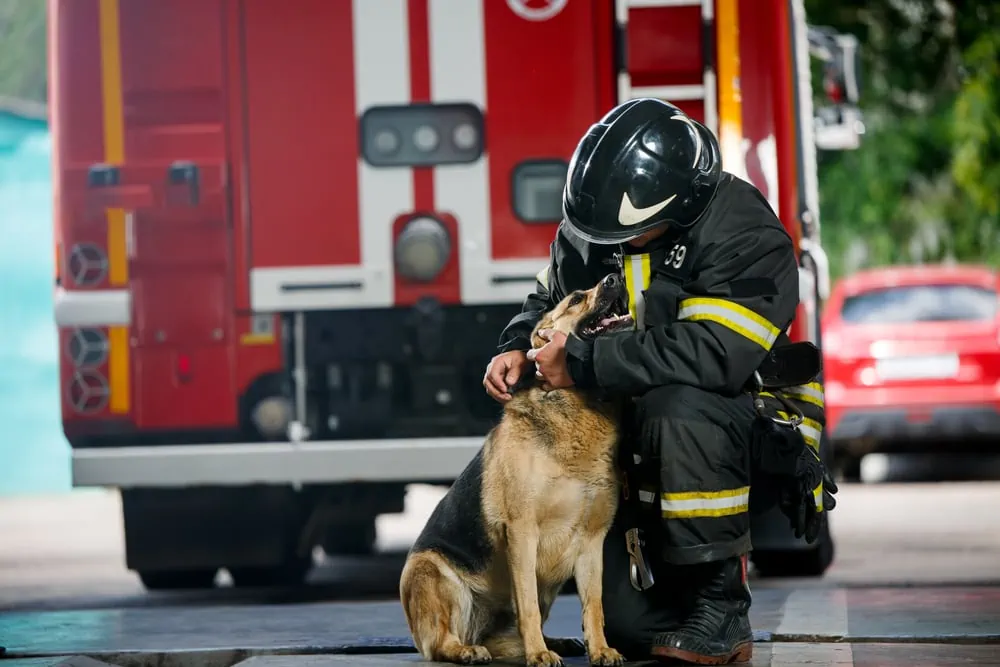
We’ve all heard that dogs are a man’s best friend. And, certainly, they are – but not only because they bring immense joy to our lives with their playful pouncing and unconditional love.
Some dog breeds are specifically trained to help people with either an emotional or physical disability – but service dogs trained as companions for people who need help with day to day tasks are particularly adept at using their paws.
The most common dog breeds used as service dogs for physical disabilities are German Shepherds, Labradors, Golden Retrievers, and sometimes Poodles (source).
These breeds are uniquely able to assist a person who needs help, whether it be to open a door or retrieve an object with his paws.
Other ways in which service dogs are able to use their paws to help include turning lights on and off, providing support for balance, or helping to transfer a person from a wheelchair to a bed (source).
Service Dog Training
Service Dogs receive extensive training and are often matched with the specific needs of their owners. They are incredibly skilled dogs who are able to maintain a positive temperament under duress and intuitively anticipate the needs of their companion.
Some service dogs, for example, are trained to work with people who have diabetes and they are able to alert their owners when blood sugar levels are either too high or too low.
How do they do that? By communicating – using body language as well as their paws.
Do Specific Breeds Use their Paws More than Others?
The short answer is yes and no. While certain breeds are more inclined to use their paws for specific reasons, most of these unique characteristics are due to both instincts as well as extensive training. Or, the dog’s particular personality makes him more inclined to use his paws to communicate with you.
Just like humans, all dogs, regardless of breed, have their own unique personalities. So, just as one dog of a particular breed who is inclined to use his paws enjoys doing so, not all dogs of the same breed will follow suit.
Pointers: Hunting Dogs who Use their Paws to Point
As mentioned earlier, particular dog breeds are instinctively adept at using their paws to point toward an object or game (prey – often birds).
These breeds are used as companions for hunters who train the dog to both search for prey as well as point toward the direction of the animal and, sometimes, retrieve it.
The most common breeds known for pointing include the English Setter and the English Pointer, both aptly named because of their instinctive ability to point.
However, while pointing is certainly part instinct, pointers are very intentionally and specifically trained to point out the location of objects or animals with their paws.
Boxers: Can They Really Box with Those Paws?
There is indeed a reason why these dogs are called boxers! They are energetic, bright, and very playful dogs. They are also known to be incredibly muscular, strong dogs who are very good with children.
And, they seem to have a tendency to stand on their hind legs and use their front paws in play, resembling the sport of boxing.
In general, boxers only “box” with other dogs and do so in a friendly manner, not aggressively.
Owners who have boxers might need to consider a big back yard in order to give these energetic companions enough space to run freely and “box” with those paws!
Unique Paw Preferences – Is your Dog a “Righty” or a “Lefty”?
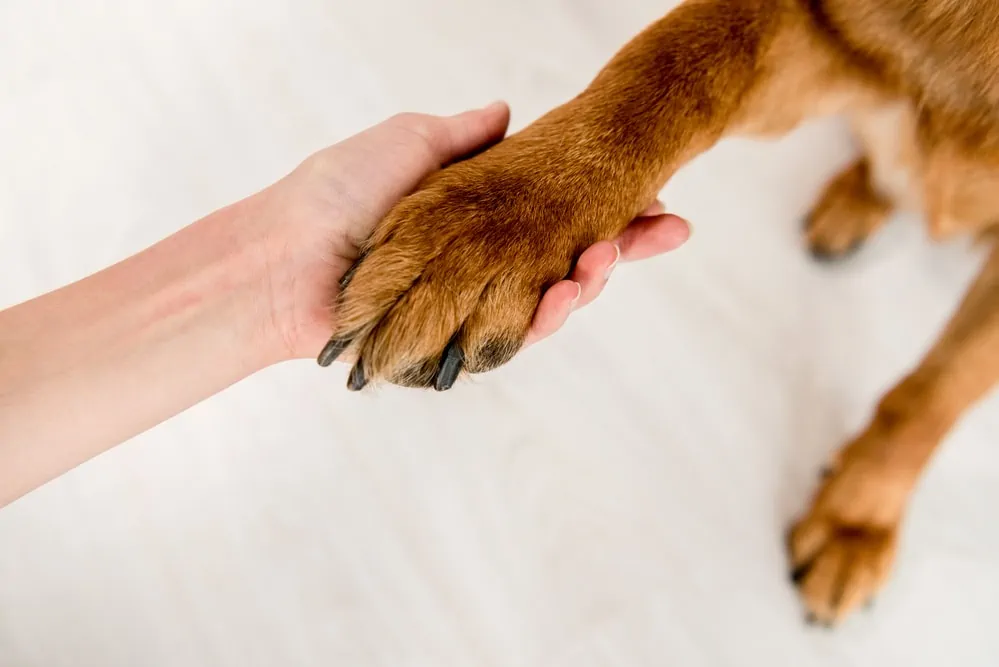
Most of us have never considered paying attention to which paw our dog favors – but just like us – they generally have a dominant paw and you can do a few quick easy tests to figure out which paw your dog favors.
Comparable to the human brain, your dog’s brain is wired in a similar way, with two hemispheres that each perform specific functions. This is the reason why your dog may have a paw preference, or what is called “laterality” by researchers in the field.
Interestingly, most humans are right-handed. But for dogs, not so. There is a much more equal sharing of both right and left preference, as well as dogs who are “ambilateral,” which simply means that they use both paws equally and don’t necessarily favor one paw over the other.
How Can you Tell if your Dog is Right or Left Pawed?
There are a few different tests you can perform to figure out which paw your dog prefers, if either. One is called the Kong Test. Another is called the First-Stepping Test.
Kong Test
You’ve probably already heard of the very popular Kong toys – stuff a treat inside and your dog is occupied until he works to get it out.
Next time you give your dog a treat inside a Kong, pay attention to which paw he uses to hold the toy still. Then, count how many times he uses his left paw to hold the toy as compared to his right.
The higher the count, whether right or left, will tell you which paw he favors.
First-Stepping Test.
This test is fairly straightforward and doesn’t require any treats. Just watch which paw your dog uses to take his first step. After a while, you may see a pattern emerge where he generally steps first with either his right or left paw, which will again show you which paw he prefers as his dominant paw.
What Does Paw Preference Mean?
Paw preference doesn’t necessarily mean much, except to show that just like humans, dogs may also be “right or left pawed.”
However, there is some evidence that shows that dogs who have a preference for their left paws may actually have a tendency to be more aggressive than those who either favor their right or who are ambilateral (no preference).
Other evidence may indicate that dogs who are right pawed seem to have better success in training to become guide or service dogs.
Still, you might be thinking, “wait a minute – my dog favors his left paw and he’s not aggressive at all.” Of course, that, too, is possible! Remember, like humans, every dog is different and there is a lot more to his personality and temperament than his paw preference.
Final Thoughts
Learning about your dog and his unique characteristics, traits, and tendencies will help you to better understand him and build a stronger relationship for both of you.
Whether your dog uses his paws to open doors, get your attention, or just to hold his bone – his paws are essential for a lot more than walking.
Remember to care for them well, and next time you are playing together, see if you can tell whether your dog, like you, maybe a “righty” or a “lefty!”

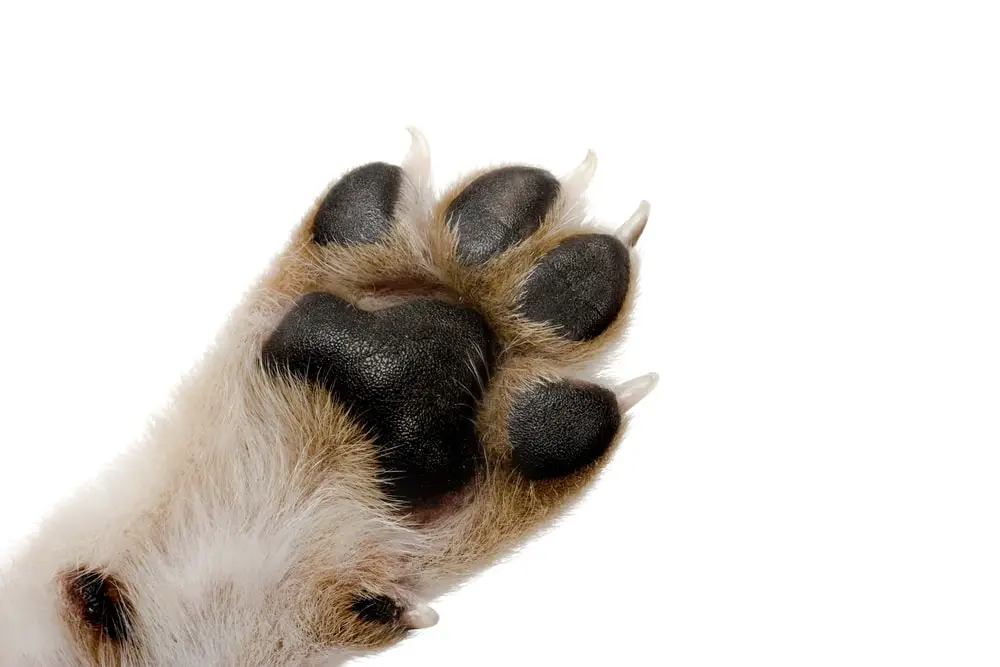
0 Comments